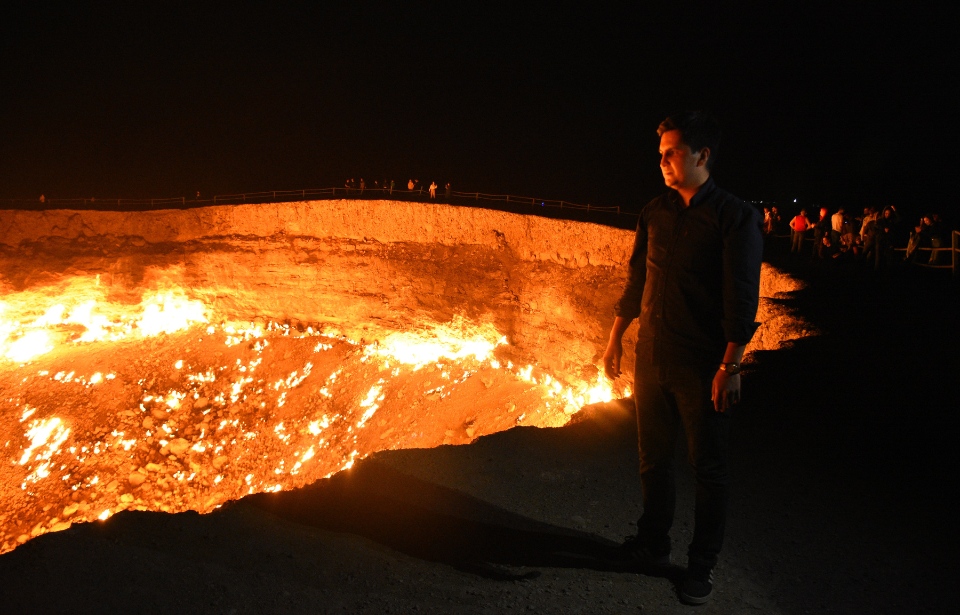In the heart of Turkmenistan lies an abandoned wonder that defies the conventional narratives of forgotten places. Known as the “Gates of Hell,” this mysterious site tells a tale of unintended consequences, born from a natural gas accident that turned an ordinary drilling operation into a perpetual inferno. Imagine a vast, fiery crater blazing relentlessly against the backdrop of a desolate landscape – a sight that beckons the curious to explore its mesmerizing depths. Join us on a journey to unearth the origins of this captivating phenomenon, understand the local legends that have woven themselves into its narrative, and contemplate the delicate balance between preserving its extraordinary nature and embracing the growing curiosity that draws adventurers to its fiery embrace.
The origins of the Gates of Hell: a fiery twist of fate
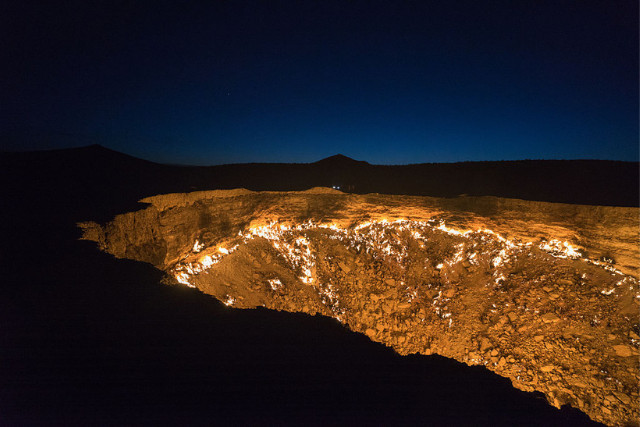
In the annals of abandoned spaces, Turkmenistan’s Gates of Hell stands out as a testament to the unexpected twists that can accompany routine endeavors. The tale begins with a natural gas drilling operation in 1971, intended to tap into the region’s substantial reserves of oil and gas within the Karakum Desert. Little did the drillers know that their quest for energy resources would give rise to a surreal and everlasting inferno.
The story unfolds near Darvaza rural council in the Karakum Desert, where a drilling rig accidentally pierced a massive underground cavern, releasing an uncontrollable flow of natural gas and causing the equipment to fall through the ground. Fearing the environmental impact of the released gas, scientists decided to set it alight, expecting the fire to burn out in a matter of weeks. However, what was anticipated as a short-lived flame turned into an eternal blaze, transforming the drilling site into the captivating spectacle we now know as the Gates of Hell.
The fiery crater, measuring approximately 230 feet in diameter, has been burning continuously for over five decades, defying initial expectations and baffling scientists. This accidental creation has become an intriguing anomaly that burns at a rate of $1 billion USD of gas per year, inviting both scientific inquiry and curious travelers to contemplate the remarkable consequences.
The endless burning and the crater’s unusual persistence
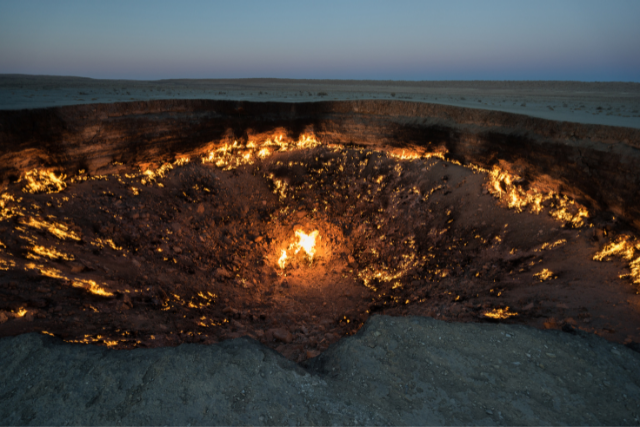
From its accidental inception, the Gates of Hell has not only defied expectations but has also baffled scientists with its unusual and persistent burning. The decision to set the natural gas aflame in 1971 was a pragmatic one, aimed at preventing the release of harmful gases into the atmosphere. However, what was intended as a short-lived solution turned into an everlasting blaze, capturing the world’s fascination.
As we peer into the heart of this geological anomaly, the persistent burning of the crater raises intriguing questions. Despite initial estimations that the flames would extinguish within a matter of weeks, the Gates of Hell continues to burn unabated over five decades later. The relentless flames have become a symbol of nature’s indomitable forces, drawing attention not only for its visual spectacle but also for the scientific puzzle it presents.
Scientists speculate that the vast reservoir of natural gas beneath the Karakum Desert fuels the perpetual combustion, but the exact mechanisms behind this phenomenon remain a subject of ongoing research. The famous Canadian explorer George Kourounis went farthest, becoming the first man to ever descend into the crater.
Journeying to Turkmenistan’s spectacular Gates of Hell
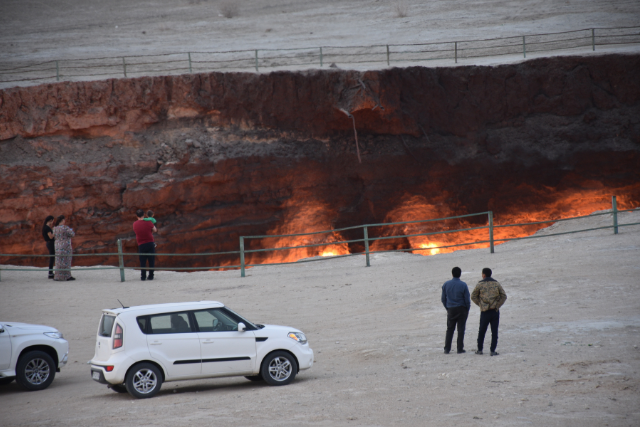
Transitioning from an accidental marvel to a coveted tourist attraction, the Gates of Hell in Turkmenistan has become an unmissable destination for thrill-seekers and adventure enthusiasts. The allure of witnessing a perpetual blaze in the heart of the Karakum Desert has turned this remote location into a hotspot for those seeking an extraordinary travel experience.
What draws people to the Gates of Hell? Firstly, it’s the sheer spectacle – a fiery crater measuring around 230 feet in diameter, casting an eerie glow against the desert backdrop. The visual intensity of the flames, especially after sunset, creates an otherworldly ambiance that lingers in the memories of those fortunate enough to witness it.
The site’s popularity has surged in recent years, with a growing number of tourists adding the Gates of Hell to their must-visit lists. However, accessibility remains a challenge, adding an extra layer of adventure for those embarking on the journey. Situated in a remote part of Turkmenistan, reaching the Gates of Hell involves traversing the Karakum Desert, often requiring off-road vehicles and experienced guides.
Despite the challenges, the journey to the Gates of Hell promises an unparalleled adventure, attracting photographers, explorers, and curious travelers eager to witness this geological wonder up close.
The future of the Gates of Hell: balancing preservation and tourism
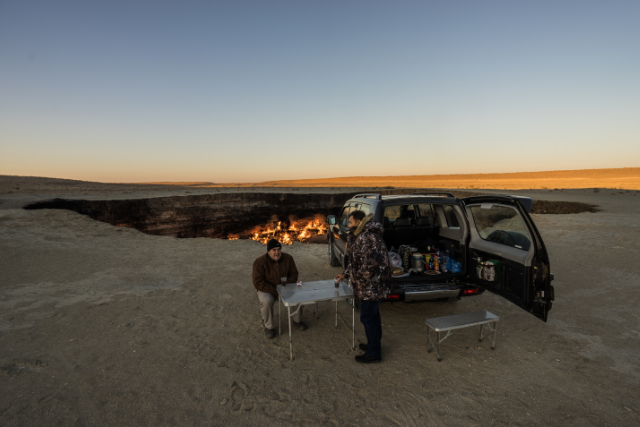
As the Gates of Hell garners increasing attention as a must-visit destination, the delicate balance between preserving this natural wonder and accommodating tourism becomes a crucial consideration for the future. The perpetual flames that have fascinated generations are now at the crossroads of conservation and visitor management.
Preservation efforts are underway to safeguard the integrity of the site. The Turkmenistan government has implemented measures to restrict uncontrolled access and mitigate potential environmental impact. Designated viewing areas, guided tours, and established pathways aim to minimize the ecological footprint and protect the delicate desert ecosystem surrounding the crater.
Read more from us: Chorazin: Jesus Christ Reportedly Put A Curse On This Ancient Village
However, the surging effects that this phenomenon has on the environment and health of the locals bring forth an array of considerations, leading to further discussions about its future. On January 8, 2022, Gurbanguly Berdymukhamedov, the president of Turkmenistan, declared that the government must find a way to extinguish the fire. On the other hand, Gianluca Pardelli, founder of Soviet Tours and also a consultant for Atlas Obscura, observed, “There is no one nearby.” Since the president also said: “We are losing valuable natural resources for which we could get significant profits and use them for improving the well-being of our people,” it’s possible that other economic factors are at play in this decision.
